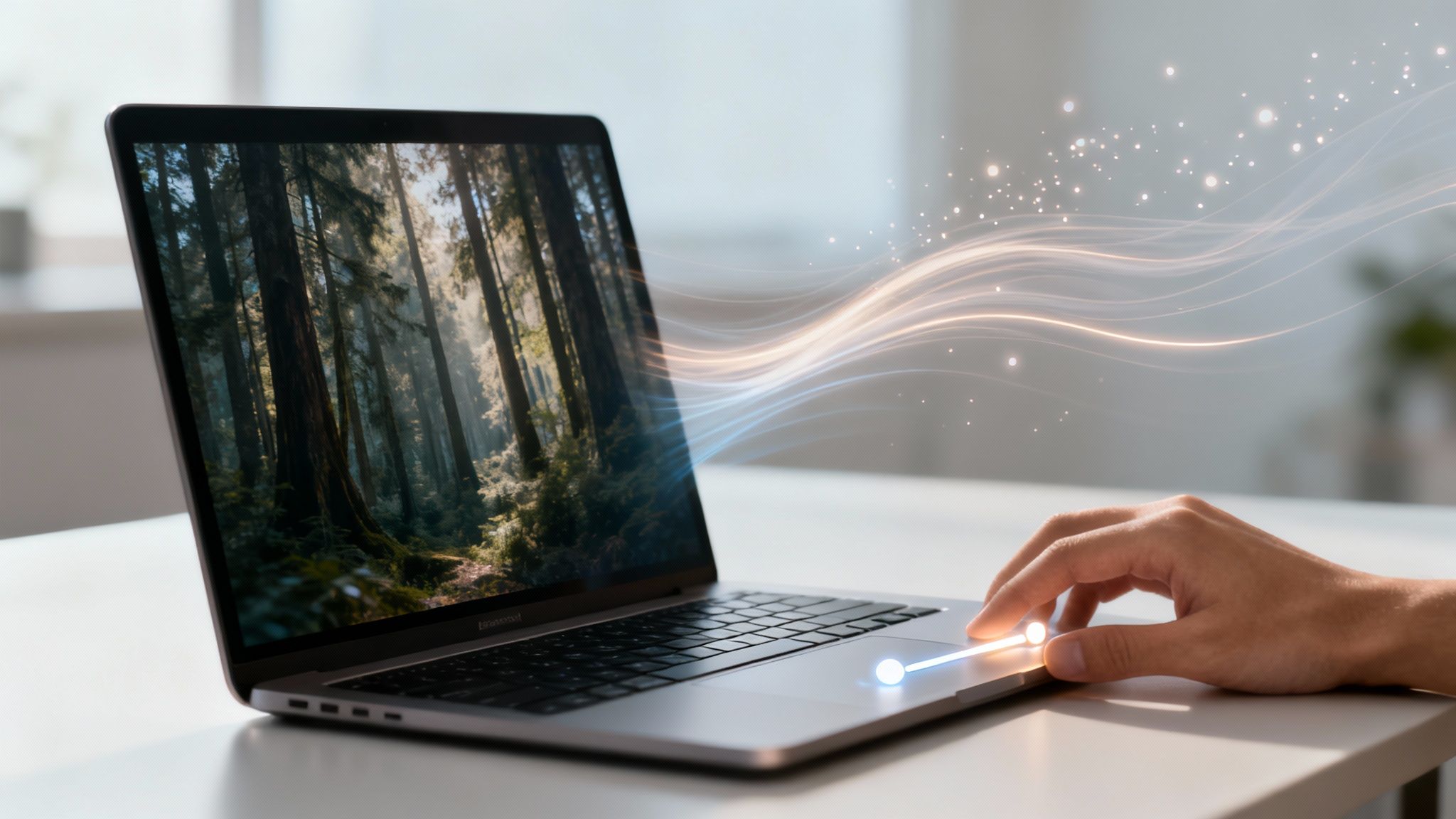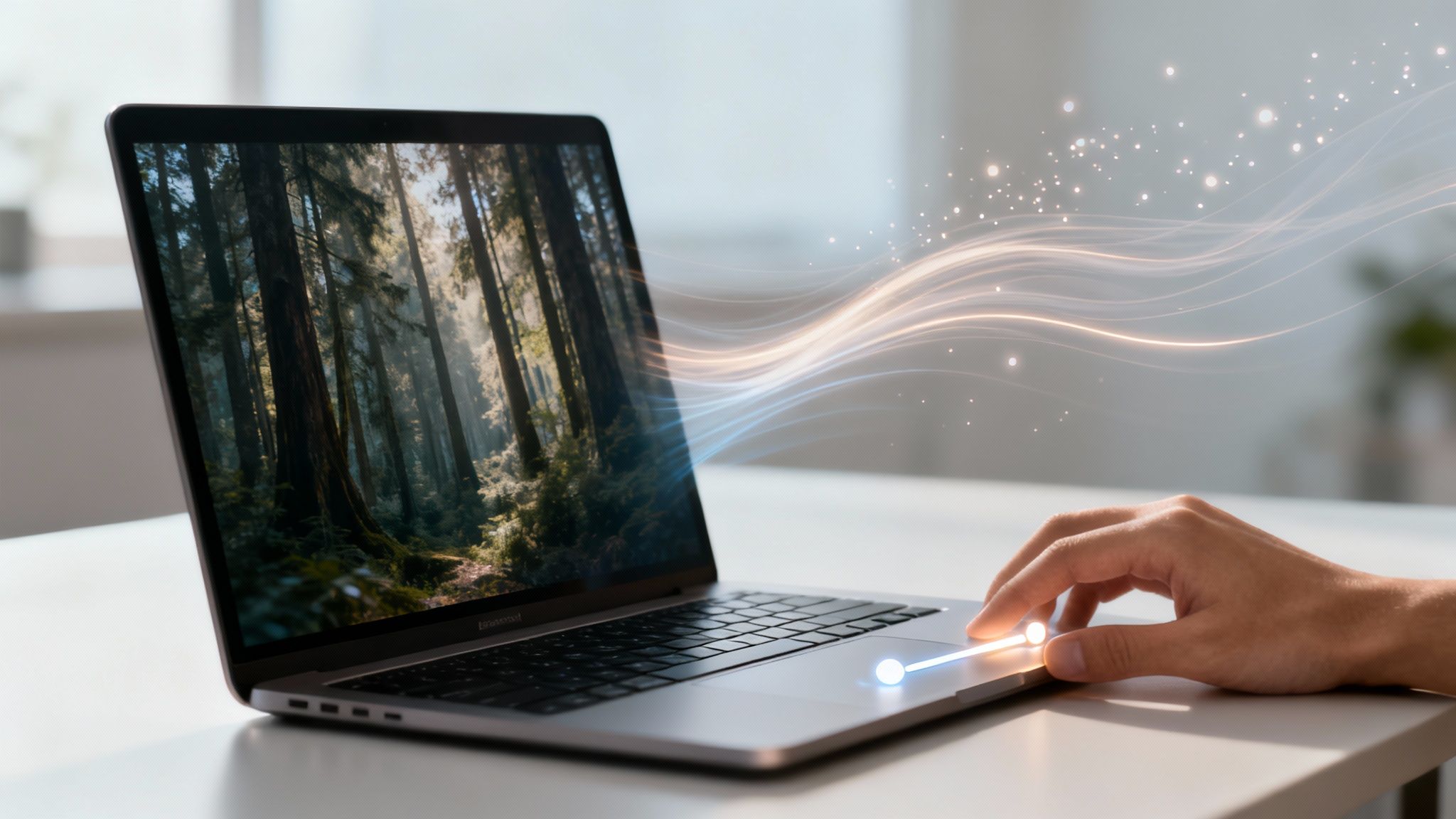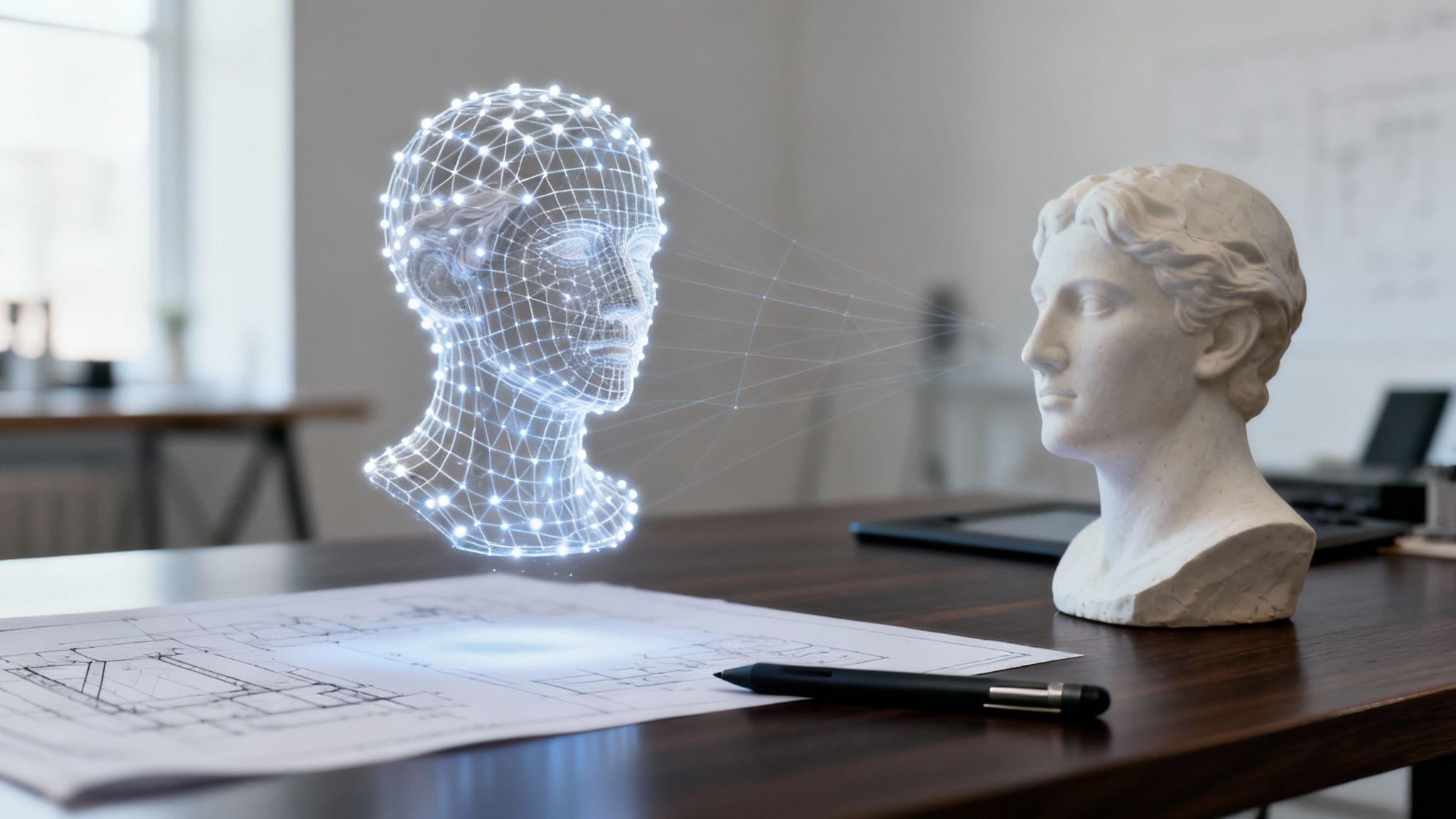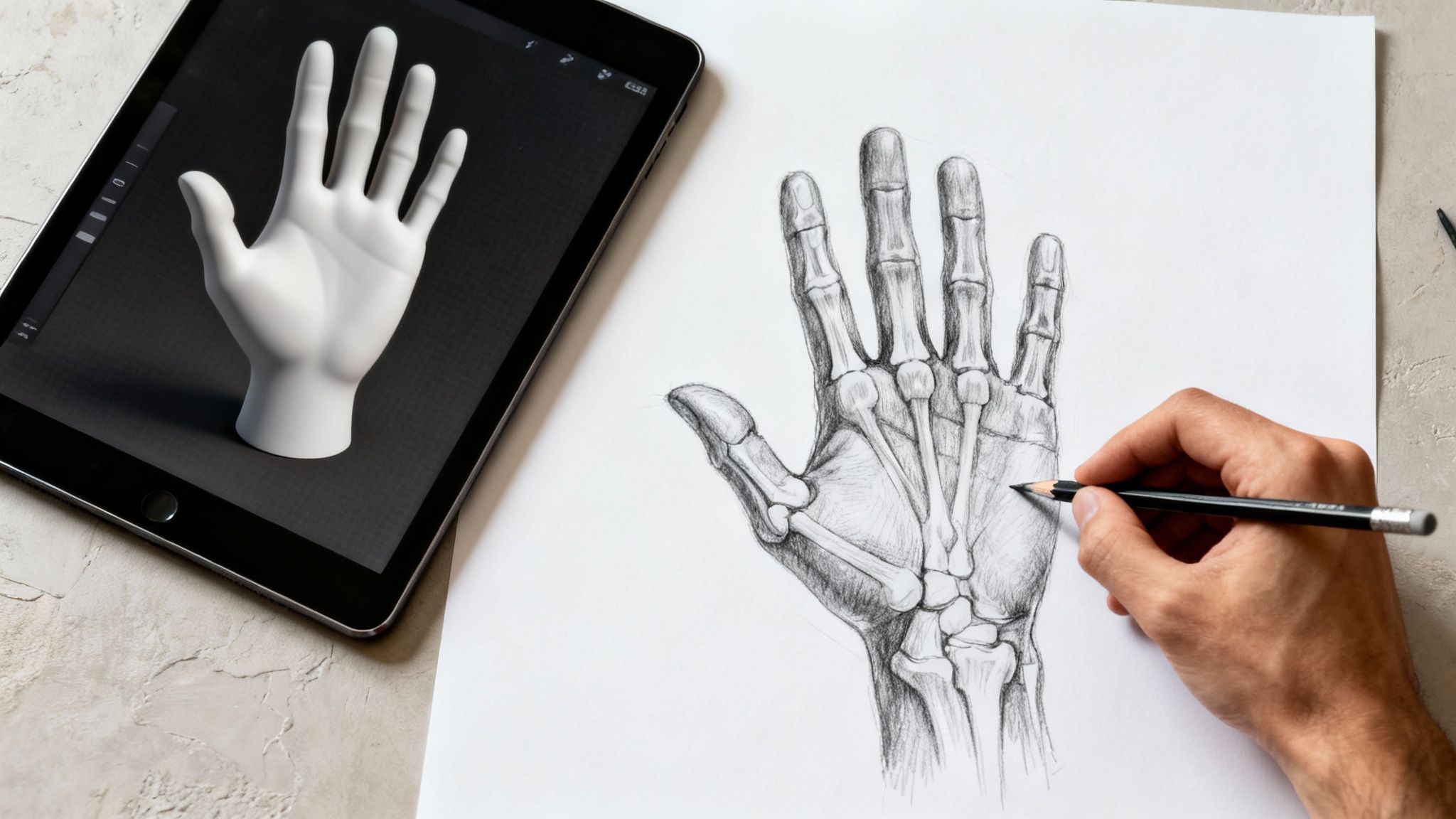AI-powered design tools are more than just software. They are sophisticated applications that leverage artificial intelligence to help enterprise teams create, modify, and perfect visual content. It is helpful to view them less as a simple tool and more as a collaborative partner—one that can suggest ideas, generate assets from text prompts, and handle routine tasks to accelerate the entire creative process in a secure environment.
Your New Creative Partner in Design
Imagine incorporating a highly capable assistant into your creative team. This assistant can generate innovative concepts, manage repetitive design tasks, and help produce high-quality visual content with unprecedented speed and efficiency. This is the new reality offered by enterprise-grade AI design tools.
This represents a fundamental shift in how creative work is performed. We are moving beyond simple commands and manual adjustments. Instead, these tools are becoming active, secure participants in the brainstorming and execution phases of visual content creation.
This technology is not intended to replace human creativity but to amplify it. It is less like a vending machine dispensing a predictable product and more like a skilled apprentice. It can learn your organisation's unique brand style, understand complex requests, and generate a range of options—from 3D models to marketing images—that a human designer can then refine and finalise.
Automation vs. Generative AI
It is important to distinguish between simple automation and true generative AI. While both enhance efficiency, they serve very different functions within a creative workflow.
- Automation: This involves programming a tool to perform a specific, repetitive job. A classic example is creating a Photoshop action that resizes 100 images to identical dimensions. The task is predefined, and the outcome is consistent.
- Generative AI: This is where the technology becomes transformative. Generative AI creates entirely new content based on your input. Instead of just resizing existing images, you could instruct it to generate 10 unique product shots in completely different settings, none of which existed previously.
Generative AI does not just follow a script; it interprets your objective and creates original content. This capability is a game-changer, allowing creative teams to explore concepts that were once too time-consuming or expensive to consider, expanding the scope of what is possible within a controlled framework.
A Practical and Secure Approach
For any large organisation, adopting new technology raises valid questions about security and compliance. This is a primary consideration.
Modern AI design tools built for enterprise teams are developed with security in mind from the outset. They operate within secure frameworks, ensuring your company’s data remains protected and that every asset generated adheres to your brand guidelines and legal standards.
This focus on a safe, compliant environment means you can integrate these powerful creative tools without introducing unnecessary risks. For an example of an AI-powered design platform that prioritises these principles, consider a tool like vibe3d.ai.
How AI Is Transforming Creative Disciplines
Artificial intelligence is not a single technology but a collection of capabilities that are fundamentally changing how creative work is accomplished, from 3D modelling to video production. For enterprise teams, this opens up new opportunities to accelerate workflows, generate assets at scale, and explore ideas that were once impractical due to time or budget constraints. The impact of ai powered design tools is being felt across the entire creative pipeline.
These tools function as powerful co-pilots for creative professionals. By handling repetitive and time-consuming tasks, they free up designers and artists to focus on high-value activities: strategy, high-level concepts, and the final refinement where human insight remains essential.
Accelerating 3D Modelling and Prototyping
In the realm of 3D design, AI is significantly accelerating asset creation. Instead of a designer manually constructing every polygon and texture, they can now use AI to generate complex surfaces, realistic environments, and intricate object details from a simple text description. This makes rapid prototyping a reality, allowing teams to visualise and test concepts in a fraction of the time it once took.
For a game developer or a product designer, this is a major shift. Imagine generating a dozen variations of a key asset in the time it used to take to build just one from scratch. This not only saves time but also expands the creative horizon, leading to richer, more detailed virtual worlds and product mockups.
AI fundamentally changes the creative equation. It shifts the focus from laborious execution to strategic direction, allowing teams to invest more energy in ideation and quality control rather than manual production.
Reimagining Image and Video Production
Marketing and advertising teams are also realising significant benefits. AI now offers a powerful method for producing on-brand visual content at scale. Tools can generate high-quality product mockups, lifestyle images, and entire campaign visuals from just a few descriptive words. This is a substantial improvement over relying on generic stock photos or arranging costly photoshoots for every new idea. You can explore this further in our guide on what is AI-generated content.
Video production is also being transformed. AI can help streamline storyboarding by visualising scenes, assist in editing by suggesting cuts or transitions, and even generate short-form content for social media campaigns. We are also seeing new creative possibilities emerge, such as transforming static photos into dynamic videos with AI.
This infographic provides an overview of how AI tools function as a partner in the creative process, influencing everything from ideation to final delivery.

As you can see, AI’s role extends far beyond simple automation. It is becoming a core component of the engine that accelerates the entire creative lifecycle.
What This Means for Enterprise Creative Teams
For large companies, integrating AI-powered design tools into workflows is not just about creating impressive visuals; it is about gaining measurable advantages that contribute to business objectives. This is where AI transitions from an experimental technology to a core strategic asset.
The first benefit teams typically notice is a significant increase in efficiency. Repetitive tasks that used to consume days—such as creating numerous variations of a 3D model, resizing an entire campaign's assets, or developing initial product concepts—can now be completed in minutes.
This frees up your most valuable creative professionals to focus on their primary responsibilities: strategy, high-level ideation, and genuine innovation.
Achieve Bulletproof Brand Consistency
One of the most significant challenges for any global enterprise is maintaining brand consistency across all markets and channels. With teams distributed geographically, small inconsistencies can emerge, diluting the brand's message.
AI tools address this by functioning as an automated brand guardian. The AI can be trained on your specific brand guidelines—logos, colour palettes, typography, and even the approved aesthetic of your imagery. Subsequently, every asset it generates is automatically on-brand.
Whether your London team is creating social media graphics or your Tokyo team is visualising a new product, the output remains perfectly aligned with corporate standards.
By integrating brand rules directly into the creation process, AI eliminates ambiguity and the need for constant manual verification. The result is a unified visual presence across every customer touchpoint.
Unlock Entirely New Creative Avenues
Beyond accelerating existing tasks, AI enables the exploration of creative ideas that were previously impractical due to high costs, long timelines, or technical limitations.
Need to visualise a new product in a dozen different global settings? Or generate a hundred unique character concepts for a new project? What once required substantial photoshoot budgets or months of artist hours can now be prototyped and visualised almost instantly.
This capacity for rapid iteration allows teams to explore more creative avenues and make better-informed decisions based on tangible visuals rather than abstract concepts. We delve deeper into this in our guide to AI tools for 3D modelling.
Impact of AI Adoption on Enterprise Creative Metrics
The transition from traditional methods to AI-powered workflows has a clear and positive effect on key performance indicators (KPIs) relevant to creative leadership. It addresses long-standing bottlenecks and creates new opportunities for growth and efficiency.
Ultimately, integrating AI is not just a technical upgrade; it is a fundamental change in the creative process that leads to faster, more consistent, and more innovative outcomes.
How to Choose the Right AI Design Tools for Your Enterprise
Selecting the right AI design tools for a large company is a significant business decision that impacts security, brand integrity, and long-term creative strategy. The market is crowded with options, but only a few are truly built to meet the demands of an enterprise environment.
The key is to look beyond marketing claims and focus on fundamental requirements. A powerful AI tool is of little value if it cannot integrate into your existing creative ecosystem. It must work in harmony with your established workflows and software.
Evaluate Seamless Integration Capabilities
Your team likely relies on established software such as the Adobe Creative Cloud. Any new AI tool must be compatible with these platforms. The objective is to avoid fragmented workflows and enable your team to adopt new technology without abandoning the tools they already trust.
A true enterprise-ready solution will offer robust APIs or direct plugins. This creates a connected workflow where assets can move effortlessly between traditional design software and the new AI environment, saving time and reducing friction for your creative professionals.
Prioritise Enterprise-Grade Security and Compliance
For any large business, security is non-negotiable. When vetting AI powered design tools, it is crucial to conduct a thorough review of their security protocols and data privacy policies. Your designs, client information, and proprietary data are at stake.
Look for solutions that offer:
- Strict Data Privacy: The platform must be fully compliant with regulations like GDPR. Critically, you need a guarantee that your data will never be used to train public models.
- Robust Access Controls: You require granular control over who can access, create, and share assets within your organisation.
- Secure Infrastructure: The tool should be hosted on a secure, reliable cloud platform with transparent data protection measures.
Choosing a tool with a strong security posture is not just a technical formality; it is a commitment to protecting your brand's intellectual property. It enables innovation to proceed responsibly and safely.
Assess Model Quality and Brand Customisation
Finally, the quality of the AI model and its ability to adapt to your specific visual identity are paramount. A generic AI that produces off-brand visuals is more of a liability than an asset.
The best enterprise tools allow you to train the AI on your unique brand guidelines—your logos, colour palettes, and specific illustration styles. For more on this, you can review our list of AI tools for designers. This customisation ensures that every asset the AI generates is not only creative but also consistently and recognisably aligned with your brand.
Integrating AI into Your Creative Process
Introducing AI-powered design tools into your organisation involves more than just implementing new software; it requires a shift in how your team approaches daily work. This should be a gradual evolution, where AI becomes a trusted creative assistant rather than a disruptive mandate.
The most effective way to begin is with small, manageable pilot projects. Select a low-risk, high-impact task, such as generating background assets for a marketing campaign or brainstorming initial concepts for a new product. This approach demonstrates immediate value, helps identify and resolve any process issues, and builds team confidence.
Fostering a Culture of Responsible Experimentation
As you begin, it is vital to establish clear guardrails. Develop straightforward guidelines for writing effective prompts and for the ethical use of AI-generated content. The goal is not to create rigid rules but to empower your team to explore the technology's capabilities responsibly.
These guidelines should cover:
- Prompting Best Practices: Simple instructions on how to communicate with the AI to achieve the desired on-brand results.
- Ethical Usage: Clear policies on data privacy, intellectual property, and avoiding the generation of biased or harmful outputs.
- Verification Standards: A streamlined process for reviewing AI-generated assets to ensure they meet quality and brand standards.
A framework like this cultivates a culture of safe experimentation, allowing creatives to innovate within a structure that maintains security and compliance.
The Human-in-the-Loop Imperative
The most successful AI integrations always maintain a human at the centre of the process. AI excels at generating ideas and handling repetitive tasks, but it lacks the critical judgment, strategic insight, and nuanced aesthetic sense of a seasoned professional. This human-in-the-loop approach ensures that AI amplifies your team's expertise, rather than attempting to replace it.
AI should be viewed as a powerful collaborator that performs the heavy lifting. This frees up human designers to focus on creative direction, final polish, and strategic decisions. This partnership is where true breakthroughs occur.
This collaborative model is becoming increasingly important as AI adoption accelerates. The Danish artificial intelligence market, for instance, is projected to grow at a compound annual rate of 33.18% between 2025 and 2031. This growth is driven by strong demand from consumers and businesses for intelligent technology that combines convenience with trust, creating an ideal environment for advanced creative tools. You can find more insights about Denmark's AI market growth on Statista.com. By adopting a human-centric strategy now, your company will be well-positioned for this next wave of creative technology.
The Future Is Unified AI Design Platforms
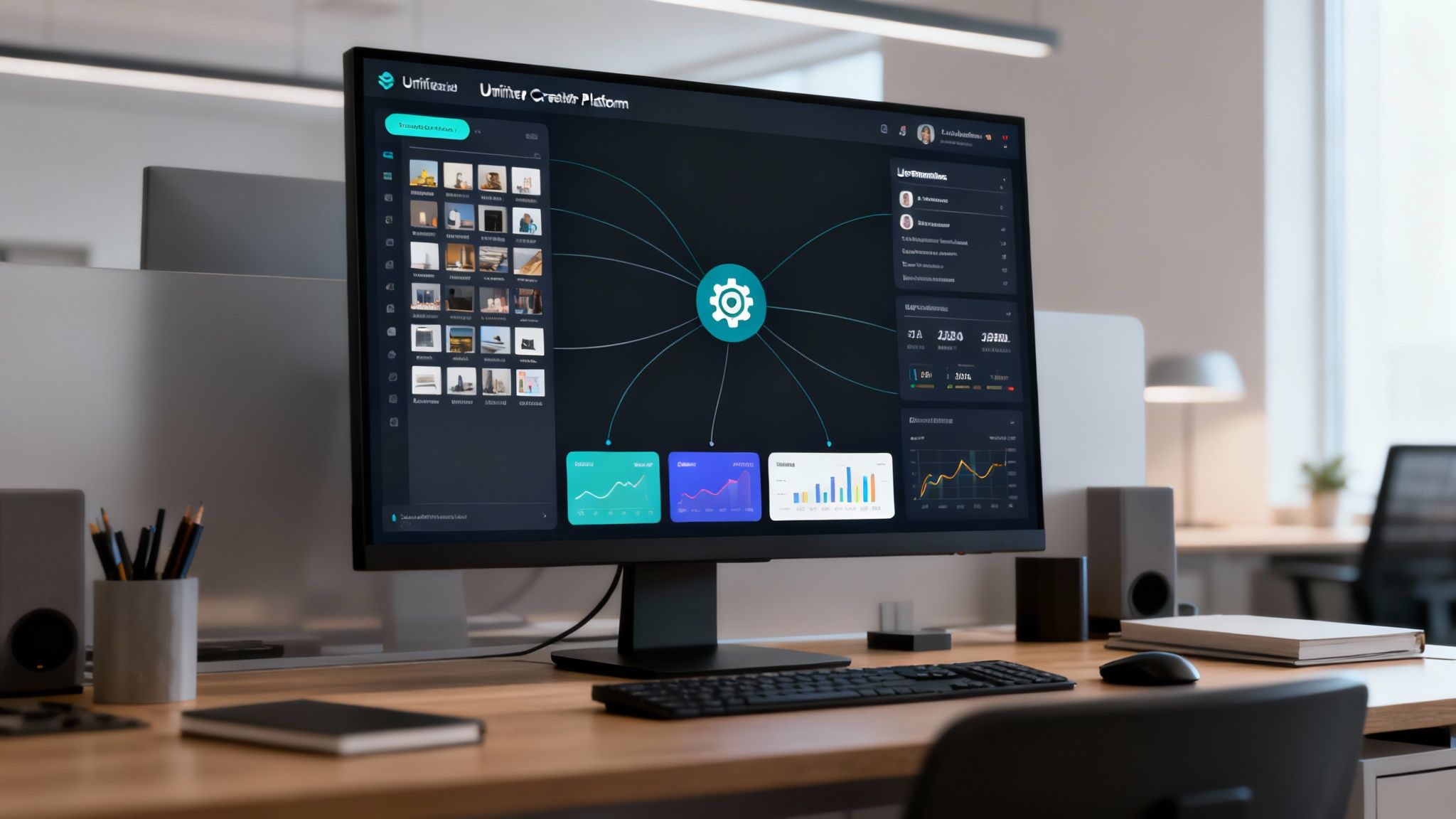
As creative teams integrate more AI-powered design tools into their daily operations, a new challenge has emerged: a fragmented landscape of disconnected applications, each with its own login, workflow, and billing cycle. This approach is not scalable for an enterprise.
The future lies in moving away from this disjointed setup toward a single, secure creative ecosystem. This is the role of unified AI design platforms.
This is analogous to replacing a cluttered workshop with a streamlined command centre. Instead of switching between different tools for 3D modelling, image generation, and video creation, all activities occur within one cohesive environment. For any enterprise seeking to adopt AI responsibly, this consolidation is essential.
Centralised Control and Consistency
A unified environment provides complete control over the creative production pipeline. It simplifies everything from managing user access to tracking every asset created. It ensures that every piece of content is generated and stored within a single, secure system.
This solves one of the biggest challenges for large organisations: brand consistency. When all creative work happens on a single platform, you can ensure that every output—from a 3D product model to a social media video—is perfectly on-brand.
Here is what that looks like in practice:
- A Single Source of Truth: All AI-generated assets are stored, versioned, and easily searchable in one central library.
- Guaranteed Brand Safety: Centralised controls ensure every image, model, and video generated is fully compliant with your brand guidelines.
- Simplified Team Management: Easily manage permissions and roles for your entire team from a single, intuitive dashboard.
- A Complete Picture: Gain a holistic view of your team's creative performance and resource utilisation across all projects.
A unified platform transforms a collection of powerful but separate AI features into a cohesive, strategic asset. It ensures every piece of creative work is compliant, secure, and aligned with business goals from the moment of creation.
This strategic shift is not just about convenience; it is becoming vital for maintaining a competitive edge. A recent study, for example, projected that the widespread adoption of generative AI could boost Denmark’s GDP by up to 8% annually within a decade.
However, the study also noted that a five-year delay in embracing integrated technologies like these could shrink that economic gain to just 2%. The incentive is clear—businesses that adopt advanced, cohesive AI design tools now will be better positioned for the future. You can read more in the report on the economic opportunities of AI in Denmark's business sector.
For enterprises, this means choosing platforms that offer not just innovative features, but a secure, unified foundation for the future of creative work.
A Few Common Questions About AI Design Tools
Whenever teams consider adopting new technology, several questions consistently arise regarding security, brand integrity, and the impact on creative professionals. Let's address these common concerns.
How Do AI Powered Design Tools Keep Our Brand Consistent?
Maintaining brand consistency is a primary concern. An enterprise requires a tool that understands and replicates its specific visual language, not a generic content generator.
Enterprise-grade platforms are designed for this purpose. They can be trained on your specific brand assets—logos, official colour palettes, typography, and even a library of your most successful campaign imagery. The AI learns your unique identity.
Once trained, every asset it creates, from a 3D model to a marketing image, incorporates your brand's DNA. It functions as a persistent brand guardian, ensuring total consistency across all channels and teams, regardless of their location.
What Should We Look for on the Security Front?
For any large organisation, security is non-negotiable. When evaluating different tools, it is essential to focus on solutions with robust data privacy policies, such as GDPR compliance, and a secure cloud infrastructure. The most critical requirement is a guarantee that your private data and creative assets will never be used to train public AI models.
The best platforms should function as a secure vault for your intellectual property. Look for features like strict user access controls and permissions. This provides granular control over who can create, view, or share sensitive creative work, preventing unauthorised use.
Are These AI Tools Going to Replace Our Designers?
No. The objective is to enhance the capabilities of your creative professionals, not to make their roles obsolete. AI excels at handling routine and time-consuming tasks, such as generating initial concepts, creating variations of an asset, or preparing files for different formats.
This frees up your designers to concentrate on high-value work: developing strategy, defining creative direction, and applying the final human touch that technology cannot replicate. The model is not human vs. machine; it is a partnership where human talent and AI technology enhance one another.
Ready to unify your creative workflow and scale your content production without compromising on security? Virtuall is the Creative OS that brings 3D, image, and video generation into a single, collaborative workspace. Discover how Virtuall can transform your creative process.



